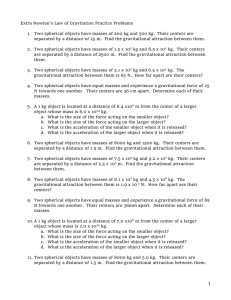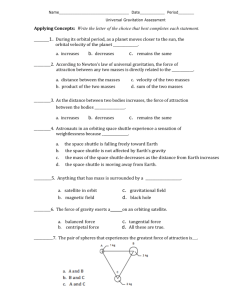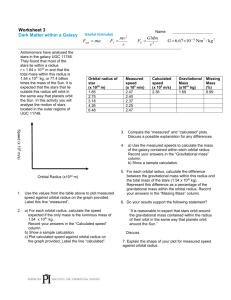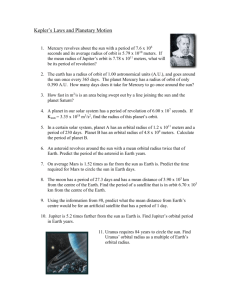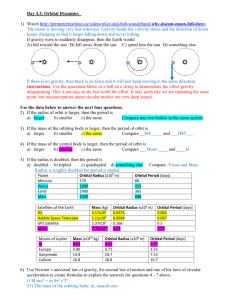Newton*s Law of Universal Gravitation
advertisement
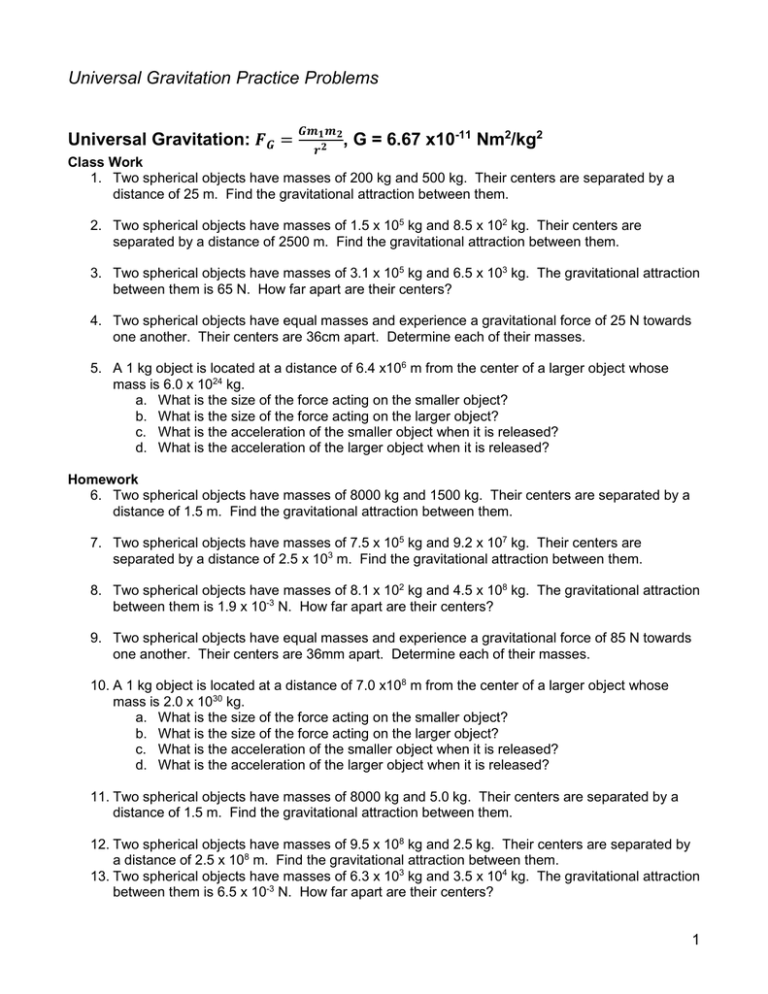
Universal Gravitation Practice Problems Universal Gravitation: 𝑭𝑮 = 𝑮𝒎𝟏 𝒎𝟐 𝒓𝟐 , G = 6.67 x10-11 Nm2/kg2 Class Work 1. Two spherical objects have masses of 200 kg and 500 kg. Their centers are separated by a distance of 25 m. Find the gravitational attraction between them. 2. Two spherical objects have masses of 1.5 x 105 kg and 8.5 x 102 kg. Their centers are separated by a distance of 2500 m. Find the gravitational attraction between them. 3. Two spherical objects have masses of 3.1 x 105 kg and 6.5 x 103 kg. The gravitational attraction between them is 65 N. How far apart are their centers? 4. Two spherical objects have equal masses and experience a gravitational force of 25 N towards one another. Their centers are 36cm apart. Determine each of their masses. 5. A 1 kg object is located at a distance of 6.4 x106 m from the center of a larger object whose mass is 6.0 x 1024 kg. a. What is the size of the force acting on the smaller object? b. What is the size of the force acting on the larger object? c. What is the acceleration of the smaller object when it is released? d. What is the acceleration of the larger object when it is released? Homework 6. Two spherical objects have masses of 8000 kg and 1500 kg. Their centers are separated by a distance of 1.5 m. Find the gravitational attraction between them. 7. Two spherical objects have masses of 7.5 x 105 kg and 9.2 x 107 kg. Their centers are separated by a distance of 2.5 x 103 m. Find the gravitational attraction between them. 8. Two spherical objects have masses of 8.1 x 102 kg and 4.5 x 108 kg. The gravitational attraction between them is 1.9 x 10-3 N. How far apart are their centers? 9. Two spherical objects have equal masses and experience a gravitational force of 85 N towards one another. Their centers are 36mm apart. Determine each of their masses. 10. A 1 kg object is located at a distance of 7.0 x108 m from the center of a larger object whose mass is 2.0 x 1030 kg. a. What is the size of the force acting on the smaller object? b. What is the size of the force acting on the larger object? c. What is the acceleration of the smaller object when it is released? d. What is the acceleration of the larger object when it is released? 11. Two spherical objects have masses of 8000 kg and 5.0 kg. Their centers are separated by a distance of 1.5 m. Find the gravitational attraction between them. 12. Two spherical objects have masses of 9.5 x 108 kg and 2.5 kg. Their centers are separated by a distance of 2.5 x 108 m. Find the gravitational attraction between them. 13. Two spherical objects have masses of 6.3 x 103 kg and 3.5 x 104 kg. The gravitational attraction between them is 6.5 x 10-3 N. How far apart are their centers? 1 14. Two spherical objects have equal masses and experience a gravitational force of 25 N towards one another. Their centers are 36 cm apart. Determine each of their masses. 15. A 1 kg object is located at a distance of 1.7 x106 m from the center of a larger object whose mass is 7.4 x 1022 kg. a. What is the size of the force acting on the smaller object? b. What is the size of the force acting on the larger object? c. What is the acceleration of the smaller object when it is released? d. What is the acceleration of the larger object when it is released? *Gravitational Field: 𝒈 = 𝑮𝑴 𝒓𝟐 Class Work 16. Compute g at a distance of 4.5 x 107m from the center of a spherical object whose mass is 3.0 x 1023 kg. 17. Compute g for the surface of the moon. Its radius is 1.7 x106 m and its mass is 7.4 x 1022 kg. 18. Compute g for the surface of a planet whose radius is twice that of the Earth and whose mass is the same as that of the Earth. 19. Compute g for the surface of the sun. Its radius is 7.0 x108 m and its mass is 2.0 x 1030 kg. 20. Compute g for the surface of Mars. Its radius is 3.4 x106 m and its mass is 6.4 x 1023 kg. 21. Compute g at a height of 6.4 x 106 m (RE) above the surface of Earth. 22. Compute g at a height of 2 RE above the surface of Earth. 23. Compute g for the surface of a planet whose radius is half that of the Earth and whose mass is double that of the Earth. Homework 24. Compute g at a distance of 8.5 x 109m from the center of a spherical object whose mass is 5.0 x 1028 kg. 25. Compute g at a distance of 7.3 x 108 m from the center of a spherical object whose mass is 3.0 x 1027 kg. 26. Compute g for the surface of Mercury. Its radius is 2.4 x106 m and its mass is 3.3 x 1023 kg. 27. Compute g for the surface of Venus. Its radius is 6.0 x106 m and its mass is 4.9 x 1024 kg. 28. Compute g for the surface of Jupiter. Its radius of is 7.1 x107 m and its mass is 1.9 x 1027 kg. 29. Compute g at a height of 4 RE above the surface of Earth. 30. Compute g at a height of 5 RE above the surface of Earth. 31. Compute g for the surface of a planet whose radius is double that of the Earth and whose mass is also double that of the Earth. 2 **Orbital Motion: 𝐓𝟐 𝐫𝟑 = 𝟒𝛑𝟐 𝐆𝐌 ,𝐯=√ 𝐆𝐌 𝐫 , RE = 6.4x106 m Class Work 32. Compute: a. The velocity of an object orbiting at a distance of 4.5 x 107 m from the center of a spherical object whose mass is 3.0 x 1023 kg. b. Compute the orbital period of that object. 33. Compute: a. The velocity of an object orbiting at a height of 6.4 x 106 m above the surface of Earth. b. Compute the orbital period of that object. 34. Mars has two moons, Phobos and Deimos. Phobos has an orbital radius of 9.4 x 106 m and an orbital period of 0.32 days. Deimos has an orbital radius of 23.5 x 106 m. a. What is the orbital period of Deimos? b. At what height above the surface of Mars would a satellite have to be placed so that it remains above the same location on the surface of Mars as the planet rotates below it. A Martian day is equal to 1.02 Earth days. Homework 35. Compute: a. The velocity of an object orbiting at a distance of 8.5 x 109m from the center of a spherical object whose mass is 5.0 x 1028 kg. b. Compute the orbital period of that object. 36. Compute: a. The velocity of an object orbiting at height of 2 RE above the surface of Earth. b. Compute the orbital period of that object. 37. Earth orbits the sun in 365.25 days and has an orbital radius of 1.5 x 1011m. a. How many days will it take Mercury to orbit the sun given that its orbital radius is 5.8 x 1010 m. b. How many days will it take Mars to orbit the sun given that its orbital radius is 2.3 x 1011m. c. It takes Jupiter 4333 days to orbit the sun. What is its average distance from the sun? 38. Compute: a. The velocity of an object orbiting at a distance of 7.3 x 108m from the center of a spherical object whose mass is 3.0 x 1027 kg. b. Compute the orbital period of that object. 39. Compute: a. The velocity, both magnitude and direction, of an object orbiting at a height of 5RE above the surface of Earth b. Compute the orbital period of that object. 40. Calculate the orbital velocity and the period, in days, for an object orbiting the sun at distance of 1.5 x 1011m. Give the period in days (The mass of the Sun is 1.989*1030 kg). 41. Jupiter has 16 moons. One of them, Io, has an orbital radius of 4.2 x 108 m and an orbital period of 1.77 days. a. What is the mass of Jupiter? 3 b. Another moon of Jupiter, Europa, has an orbital radius of 6.7 x 108 m. What is its orbital period? c. Another moon of Jupiter, Ganymede, has an orbital period 7.2 days. What is the radius of its orbit? d. Jupiter rotates once every 0.41 days. At what orbital radius will a satellite maintain a constant position? General Problems 42. As shown in the diagram below, a 5.0 kg space rock is located 2.5x107 m from the center of the earth. The mass of the earth is 6.0x1024 kg. Earth Space Rock a. Determine the force of gravity acting on the space rock, due to the earth. Calculate the magnitude and state the direction. b. Compare your answer in a) to the force of gravity acting on the earth, due to the space rock. Indicate that force on the diagram above. c. On the diagram above, indicate the direction the space rock would accelerate if released. Label that vector “a”. d. Calculate the acceleration the rock would experience. e. **If instead of falling, the object were in a stable orbit, indicate on the diagram above a possible direction of its velocity. Label that vector “v”. f. **Calculate the velocity the rock needs to be in a stable orbit. g. **Calculate the period of the rock orbiting the earth. 4 43. As shown in the diagram below, a 2000 kg spacecraft is located 9.2x106 m from the center of the earth. The mass of the earth is 6.0x1024 kg. Earth Spacecraft a. Determine the force of gravity acting on the spacecraft, due to the earth. Calculate the magnitude and state the direction. b. Compare your answer in a) to the force of gravity acting on the earth, due to the spacecraft. Indicate that force on the diagram above. c. On the diagram above, indicate the direction the spacecraft would accelerate if released. Label that vector “a”. d. Calculate the acceleration the spacecraft would experience. e. **If instead of falling, the spacecraft were in a stable orbit, indicate on the diagram above a possible direction of its velocity. Label that vector “v”. f. **Calculate the velocity the spacecraft needs to be in a stable orbit. g. **Calculate the period of the spacecraft orbiting the earth. 5 44. As shown in the diagram below, a 1000 kg asteroid is located 6.8x106 m from the center of the Mars. The mass of the Mars is 6.4x1023 kg. Mars Asteroid a. Determine the force of gravity acting on the asteroid, due to the Mars. Calculate the magnitude and state the direction. b. Compare your answer in a) to the force of gravity acting on the Mars, due to the asteroid. Indicate that force on the diagram above. c. On the diagram above, indicate the direction the asteroid would accelerate if released. Label that vector “a”. d. Calculate the acceleration the asteroid would experience. e. **If instead of falling, the asteroid were in a stable orbit, indicate on the diagram above a possible direction of its velocity. Label that vector “v”. f. **Calculate the velocity the asteroid needs to be in a stable orbit. g. **Calculate the period of the asteroid orbiting the earth. 6 Answers 1. 1.067x10-8 N 2. 1.361x10-9 N 3. 0.045 m 4. 220400 kg 5. a) 9.77 N b) 9.77 N c) 9.77 m/s2 d)1.63 x10-24 m/s2 6. 0.000356 N or 3.56 x10-4 N 7. 0.000736 N or 7.36 x10-4 N 8. 113.229 m 9. 40640 kg 10. a) 272 N b) 272 N c) 272 m/s2 d) 1.36 x10-28 m/s2 11. 1.19 x10-6 N 12. 2.53 x10-18 N 13. 1.50 m 14. 220400 kg 15. a) 1.71 N b) 1.71 N c) 1.71 m/s2 d) 2.31 x10-23 m/s2 16. 0.0099 m/s2 17. 1.71 m/s2 18. 2.44 m/s2 19. 272 m/s2 20. 3.69 m/s2 21. 2.44 m/s2 22. 1.09 m/s2 23. 78.2 m/s2 24. 0.0462 m/s2 25. 0.375 m/s2 26. 3.82 m/s2 27. 9.08 m/s2 28. 25.13 m/s2 29. 0.392 m/s2 30. 0.27 m/s2 31. 4.89 m/s2 32. a)670 m/s b) 4.2 x 105 s 33. 5591.57 m/s b) 1.44 x 104 s 34. a) 1.26 days b) 2.04 x107 m 35. a) 2.0 x 104 m/s b) 2.7 x 106 s 36. a) 4560 m/s b) 5.09 x 103 s 37. a) 88 days b) 693.5 days c) 7.8 x1011 m 38. a) 1.66 x 104 m/s tangential to orbit b) 2.79 x 105 s 39. a) 3230 m/s tangential to orbit b) 7.4 x 104 s 40. 3.0 x 104 m/s; 365 days 41. a) 1.90*1027 kg b) 3.57 days c) 1.07 x109 m d) 2.58 x107 m 42. a) 3.2 N left b) same force to right c) (←)from rock towards earth d) 0.64 m/s2 e) (↑or↓) up or down from rock f) 4000 m/s g) 39260 s 43. a) 9457 N left b) same force to right c) (←)from spacecraft towards earth d) 4.73 m/s2 e) (↑or↓) up or down from spacecraft f) 6595 m/s g) 8764 s 44. a) 923 N left b) same force to right c) (←)from asteroid towards mars d) 0.92 m/s2 e) (↑or↓) up or down from asteroid f) 2505 m/s g) 17052 s 7

